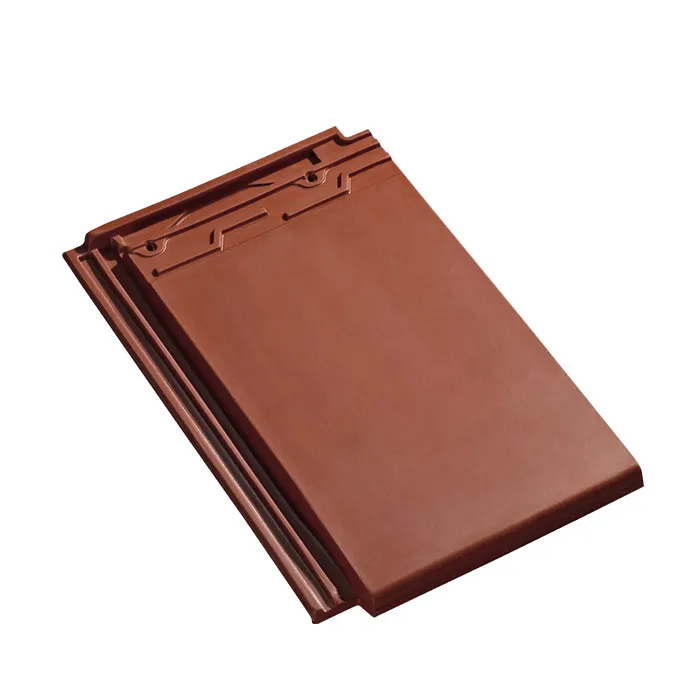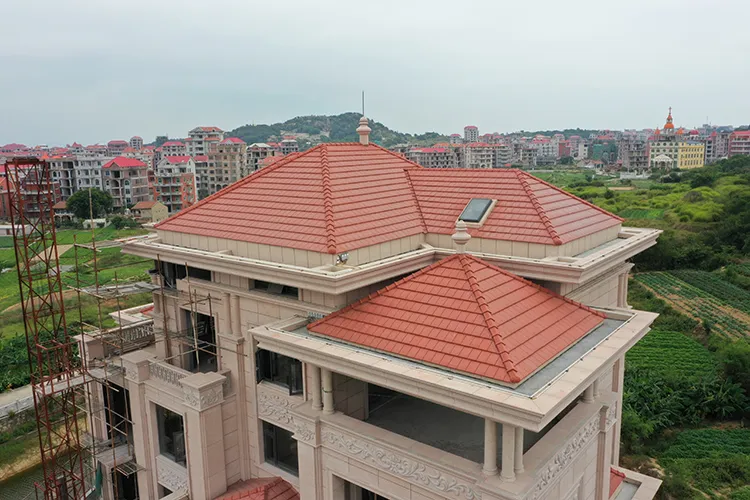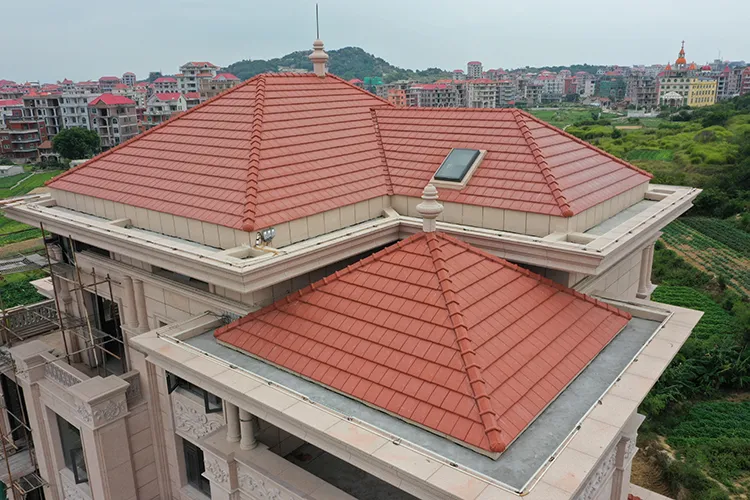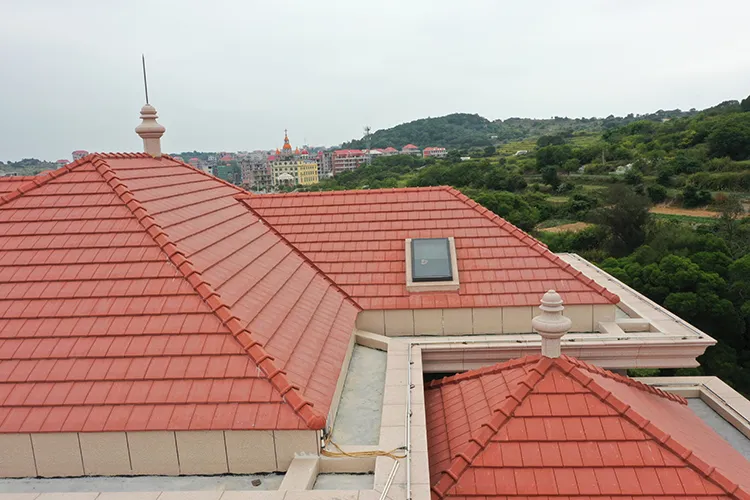As a traditional roofing material, clay tiles have been used for thousands of years. They are widely used in various types of buildings because of their unique aesthetics, durability and environmental protection. Clay tiles are divided into many types, and flat clay tiles are one of them. Because of their flat appearance and simple lines, they are suitable for modern architectural styles. However, with the continuous improvement of people's requirements for the performance of roofing materials, the issue of the waterproofness of flat clay tiles has aroused widespread concern.
This article will analyze the waterproof performance of flat clay tile roofs in detail, discuss it from multiple angles such as its material, structure, and installation method, and answer the question "Is the waterproofness of flat clay tile roof tiles good?"

What are the material characteristics of flat clay tiles?
To discuss the waterproofness of flat clay tiles, we must first understand its material and physical properties. Clay tiles, as the name suggests, are mainly made of clay. Clay is a natural material that is suitable as a raw material for roof tiles because of its rich mineral composition and good plasticity. The production process of flat clay tiles is similar to that of traditional clay tiles. After high-temperature firing, they form building materials with a certain hardness and density.
Breathability and waterproofness of clay tiles
Clay tiles are porous, which makes the clay tiles themselves have a certain degree of breathability during the firing process. Although the porosity brings better breathability to clay tiles, allowing tiles to breathe and prevent internal water vapor accumulation, it also makes clay tiles have a certain degree of water absorption without surface treatment. This water absorption does not mean that the tiles will completely lose their waterproof function, but if exposed to rain or humidity for a long time, untreated clay tiles may absorb some water, thereby affecting their waterproofness.
High-temperature firing increases density
After high-temperature firing, the material structure of flat clay tiles changes, the impurities in the clay are decomposed, the internal pores are reduced, and the density of the tiles is significantly increased. This high-temperature firing process gives flat clay tiles a higher waterproof ability. The water absorption rate of fully fired clay tiles is greatly reduced, and they can well resist the penetration of water in general rainfall environments.
Waterproofing enhancement effect of surface treatment
Modern flat clay tiles are usually surface treated during the production process, such as glazing or applying waterproof coating. These treatments can not only increase the aesthetics of the tiles, but also effectively enhance the waterproof performance of the tiles. The surface of the glazed flat clay tiles forms a smooth and impermeable protective layer, which can significantly reduce the possibility of rainwater penetrating into the tiles. Even unglazed clay tiles can be further improved by spraying special waterproof coatings.

How is the structural design and waterproofness of flat clay tiles?
Flat clay tiles are different from traditional corrugated clay tiles in structural design. Corrugated tiles rely on their curved surface design to naturally guide the flow of rainwater through the wavy tiles, thereby improving the waterproof effect. Flat clay tiles, on the other hand, are relatively flat in shape and have no curves or grooves on the surface, which makes people worry about their drainage and waterproof performance. The following will analyze its waterproof performance from the perspectives of tile overlap, roof slope, etc.
Tile overlap method
The waterproofness of flat clay tiles depends largely on the overlap design between tiles. Although the shape of a single flat clay tile is flat, there is a certain overlap between the tiles during the installation process. This overlapping method can effectively prevent rainwater from penetrating into the roof.
Usually, when installing flat clay tiles, there will be a certain overlap distance between the front and rear rows of tiles, which can form a natural waterproof barrier. Even if rainwater flows over the surface of the tile, it will be smoothly discharged through the overlap of the layers of tiles, thus preventing rainwater from directly entering the roof. At the same time, the edge design of the side of the flat clay tile usually has a small protrusion, which can further enhance the sealing effect between the tiles and prevent rainwater from penetrating from the side.
The impact of roof slope on waterproofness
The slope design of the roof also has a vital impact on the waterproofness of flat clay tiles. Generally speaking, the greater the slope of the roof, the faster the rainwater is discharged, and the shorter the time the rainwater stays on the tile surface, so the better the waterproof effect. Because of its flat surface, if the flat clay tile is used on a roof with a smaller slope, the rainwater will be discharged more slowly, increasing the possibility of water penetrating into the tile joints. Therefore, when designing and installing a flat clay tile roof, it is usually recommended that the roof slope be at least 25 degrees to ensure that rainwater can be drained quickly.
For roofs with lower slopes, it is particularly important to install a waterproof underlay (such as a waterproof membrane). The waterproof underlay acts as an additional waterproof barrier under the roof tiles, which can effectively prevent roof leaks caused by rainwater penetration. Even if a small amount of water seeps between the tiles, the waterproof underlay can prevent the water from entering the room further.
Roof drainage system design
In addition to the design of the tiles themselves, the reasonable design of the roof drainage system is also crucial to the waterproof effect. The drainage facilities such as the eaves gutters and rainwater pipes on the roof should be reasonably designed to ensure that rainwater can be drained quickly and not stagnant on the roof. If the drainage system is not smooth, it may cause rainwater to backflow or accumulate, thereby increasing the risk of tile seepage. Therefore, when using flat clay tiles, special attention must be paid to the maintenance of the roof drainage facilities, and blocked fallen leaves or debris must be cleaned regularly to ensure the smooth drainage system.

What effect does the installation process have on waterproofness?
The waterproofness of flat clay tiles depends not only on the material and design of the tiles themselves, but also on the installation process. The quality of installation directly determines whether the tiles can fully exert their waterproof performance.
The importance of a professional construction team
The installation process of flat clay tiles is relatively complicated, especially the overlap, arrangement angle and joint treatment of tiles, which require a professional construction team to complete. If the tiles are installed improperly, gaps appear at the overlap position, or the tiles are not arranged neatly, rainwater may penetrate into the roof through these gaps. Therefore, hiring a professional construction team to ensure that the tiles are installed in accordance with the specifications and the joints are tight is the key to ensuring the waterproof performance of flat clay tiles.
Installation of waterproof cushion
The installation of waterproof cushion is an important part of the roof waterproofing project. For flat clay tile roofs, the role of waterproof cushion is particularly prominent. Even if the tiles are well overlapped, the waterproof cushion still serves as an additional line of defense to prevent leakage caused by construction defects or extreme weather. The waterproof cushion is usually made of high-strength waterproof membrane material, which is laid between the structural layer and tiles of the roof to effectively isolate moisture.
Treatment of key parts such as ridges and eaves
The ridges, eaves, skylights and other locations are key waterproof parts of the roof, and tiles in these places often require special treatment. If the tiles in these parts are improperly installed or the sealing treatment is not in place, it is easy to leak. Therefore, during the installation of flat clay tiles, construction workers should pay special attention to the waterproof treatment of these key parts to ensure that the joints between tiles and other building components are tight to prevent rainwater from penetrating through these weak points.

Comprehensive evaluation of the waterproofness of flat clay tiles
Based on the analysis of multiple factors such as materials, structural design, and installation process, we can draw the following comprehensive evaluation of the waterproofness of flat clay tiles.
Good waterproof foundation
From the material point of view, flat clay tiles are fired at high temperature and have a lower water absorption rate, especially tiles that are glazed or treated with waterproof coatings, which have better waterproof performance. Its dense structure can effectively resist the erosion of rainwater and is suitable for building roofs under most climatic conditions.
Structural design improves waterproofing effect
Although flat clay tiles do not have the curved drainage effect of corrugated tiles, good waterproofing performance can still be achieved through reasonable overlap design and appropriate roof slope. Especially when the roof slope reaches more than 25 degrees, the drainage speed of rainwater is fast enough to prevent moisture from being retained on the tile surface for a long time, further reducing the risk of water seepage.
Installation quality is the key
The waterproofness of flat clay tiles depends largely on the quality of the installation process. The standardized operation of the professional construction team, the correct laying of the waterproof cushion layer, and the waterproof treatment of key parts are all necessary conditions to ensure the waterproof effect of the roof. If these links are not handled properly, even if the material and structural design are good, the waterproofing performance cannot be fully guaranteed.
Maintenance is crucial
Finally, the waterproofing performance of the roof is also closely related to the later maintenance. Although the flat clay tile roof has good waterproofing, it is inevitable that the tiles will shift and break if it is exposed to wind and rain for a long time. Therefore, regular inspection and timely repair of damaged tiles and cleaning of the drainage system are necessary measures to ensure the long-term waterproofing performance of the roof.
With a strong focus on innovation and customer satisfaction, Rongguan is a premier manufacturer of quartz countertops and terrazzo flooring. Our products, exported to over 20 countries, are renowned for their superior quality and affordable prices. Whether you're looking for low-cost solutions or unique designs, we offer flexible purchasing options, bulk discounts, and reliable supply chains to meet your requirements.

